St. Augustine, Florida
On August 28, 1565, the day of the Feast of Saint Augustine, Don Pedro Menendez de Aviles, the Spanish sailor, first sighted the coast of Florida. He founded a new city here and named it St. Augustine. Thus St. Augustine is the nation’s oldest city and as you walk through its streets, its five hundred year old history comes alive.

About The Community
Known as the “Ancient City,” Saint Augustine, in St. John’s County lies between North East and Central East Florida and is the longest continually inhabited European founded city in the United States. Its mild climate, rich heritage and numerous recreational facilities make St. Augustine a unique getaway. It is so easy to fall in love with its delightful historic district, with cobblestone streets and its quaint cafes, bars, unique shops and bed-and-breakfast inns.

Important Links (Suggest / Report)
There are numerous relics from its early days like the Castillo de San Marcos National Monument, with its elaborate double drawbridge entrance spanning forty feet above a now dry moat. It has, along with the neighboring Fort Mose to the north and Fort Matanzas to the south, served as the city’s outer defenses for many years, reminiscent of the early Spanish empire. Its intricate architecture built of coquina, a virtually indestructible limestone comprised of broken seashells and corals have withstood three centuries of enemy shelling and violent storms.

Fort Matanzas watchtower was a vantage point to look out for enemy vessels approaching. Today along with Castillo de San Marcos it overlooks the picturesque Mantazas Bay, with its sleek modern-day sailing vessels. Cross the Historic Bridge of Lions to reach the St. Augustine Municipal Marina that makes boating access ultra convenient by sea, river or intercoastal waterway.
Vicinity of St. Augustine
Additional Details
The Colonial Spanish Quarter is a living history museum that brings to life the era of the Spaniards in 1740 St. Augustine. Costumed interpreters tell the tale as you watch blacksmiths, carpenters, leatherworkers, candle makers at work. The Lightner Museum, formerly Henry Flagler’s Alcazar Hotel, houses an array of artifacts, from Native American to stuffed birds and steam-engine models. Built in1889 in distinctive Spanish Renaissance styling, the building is a reminder of the days of style and opulence.

Today, with its population of approximately fourteen thousand, St. Augustine continues to thrive and prosper with its rich heritage of Spanish and English, Greek and Minorcan, Native American and African American influences. Ponte Vedra, home of PGA and Association of Tennis Professionals (ATP) are a 20-minute drive from the downtown St. Augustine. Sports lovers can also enjoy fishing, diving, surfing, parasailing and other water sports along the forty-three miles of pristine beaches.
Numerous vantage points in town bring you the joy of watching the sun rising over the Atlantic Ocean horizon and the serenity of watching it set beyond the salt marshes along the Intracoastal Waterway. Life here is truly beautiful.

